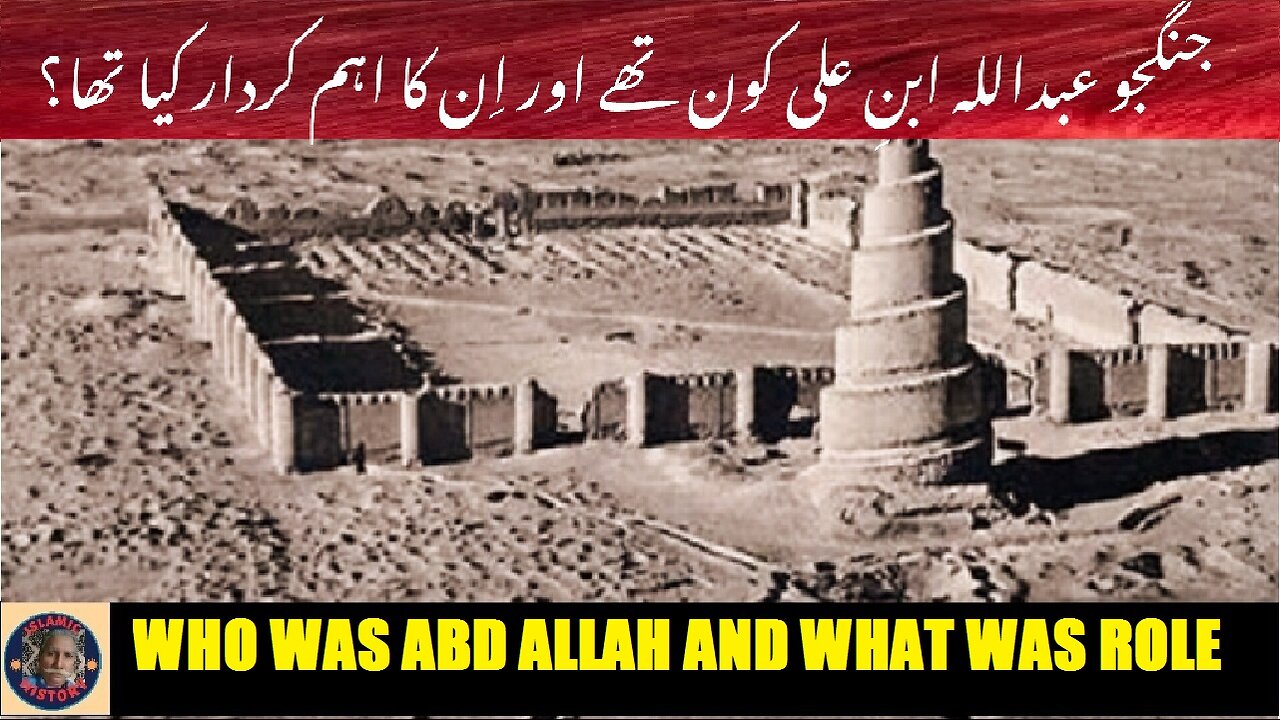Premium Only Content

Warrior Abd Allah and his leading role جنگجو عبداللہ ابن علی کون تھے اور ان کا اہم کردار کیا تھا
@islamichistory813 #HistoricalFigures #MilitaryLeadership #CulturalImpact
Who was Warrior Abd Allah Ibn Ali and what was his leading role?
Dekhti Aankhooon aur sountay kaanoon ko Asslamoalaikum, sisters, brothers friends and elders, In this warrior leaders informative videos, we are describing the life of Warrior Abd Allah Ibn Ali, a key leader whose actions and decisions left a lasting mark on history. Through a detailed analysis, we will discuss his military strategies, leadership qualities, and the historical context in which he operated. Watch complete video and get to know the essence of his character and the reasons behind his enduring legacy.
Abu Muhammad Abd Allah ibn Ali was a member of the Abbasid dynasty and uncle to the first two Abbasid caliphs, al-Saffah (r.?750–754) and al-Mansur (r.?754–775)., and played a leading role in its rise to power during the Abbasid Revolution. As governor of Syria, he consolidated Abbasid control over the province, eliminating the remnants of the Umayyad dynasty and suppressing pro-Umayyad uprisings. After the death of his nephew and first Abbasid caliph, al-Saffah, in 754, he launched a bid for the caliphal title against al-Saffah's brother, al-Mansur, but was defeated and imprisoned. He was killed in 764.
By early 749, the anti-Umayyad uprising that had begun under Abu Muslim in Khurasan had prevailed in the eastern lands of the Caliphate, and the Khurasani armies swept west across Persia to the borders of Iraq. In October 749, al-Saffah was proclaimed Caliph at Kufa, and quickly gained the acceptance of Abu Muslim and the Kufans, thereby forestalling an Alid bid for control of the revolution. To cement Abbasid control, al-Saffah now appointed members of his own family to command the armies: his brother, the future al-Mansur, was sent to lead the Siege of Wasit, while Abd Allah was sent to confront the Umayyad caliph Marwan II (r.?744–750) in the Jazira.
Thus Abd Allah held the supreme command in the decisive Battle of the Zab, where the Abbasid forces defeated Marwan II, and led the pursuit of Marwan, first to Syria, where he captured the Umayyad capital, Damascus, and then to Palestine, forcing Marwan to flee to Egypt. His brother Salih followed Marwan to Egypt, where the Umayyad ruler was captured and executed.
Governorship of Syria and suppression of Umayyad risings
As the first Abbasid governor of Syria, Abd Allah proved himself an implacable enemy of the Umayyads, vigorously persecuting the family's members. According to the Swedish Orientalist Karl Vilhelm Zetterstéen, "he shrank from no method to exterminate them root and branch. During his stay in Palestine, he had about eighty of them murdered at one time." So effective was this persecution, that only a single member of the dynasty, Caliph Hisham ibn Abd al-Malik's grandson Abd al-Rahman ibn Mu'awiya, managed to escape death and flee to al-Andalus, where he established a new Umayyad dynasty.
This harsh suppression, and the depredations of the victorious Khurasani soldiers, soon provoked an uprising by the Syrian tribes, led by the governor of Jund Qinnasrin, Abu'l-Ward ibn al-Kawthar. They were joined by Abu Muhammad al-Sufyani, a descendant of Caliph Mu'awiya I, who put himself forward as a candidate for reviving the Umayyad Caliphate. The rebels were at first successful, routing an Abbasid army under Abd Allah's brother Abd al-Samad near Qinnasrin, but Abd Allah finally dealt a heavy defeat on them at Marj al-Akhram in late 750. Abu'l-Ward fell, while Abu Muhammad fled to the desert. A nephew of Abu Muhammad, al-Abbas ibn Muhammad, rose up in Aleppo shortly after, but al-Mansur, who governed the Jazira, sent troops that quelled the uprising before Abd Allah could arrive. Abd Allah then marched onto the frontier fortress of Sumaysat, where disparate Umayyad loyalists had gathered under Ishaq ibn Muslim al-Uqayli.[6] In the event, a negotiated settlement was reached between Ishaq and al-Mansur, and many of the pro-Umayyad leaders were then accepted into the ranks of the Abbasids. Another uprising, headed by Aban ibn Mu'awiya, a grandson of Hisham ibn Abd al-Malik, erupted in the summer of 751 near Sumaysat, forcing Abd Allah to interrupt a raid into Byzantine territories to suppress it. Another Umayyad loyalist, Abd al-Samad ibn Muhammad ibn al-Hajjaj ibn Yusuf, managed to escape defeat and capture until 755.
So sisters brothers friends and elders, tomorow we are going to described How Abd Allah Ibn Ali was trying to become Caliph. Allah hafiz
===========================
-
 12:22
12:22
ISLAMIC HISTORY
39 minutes agoKhalid bin Walid (RA) Islamic Warrior Episode 63 خالد بن ولید رضی اللہ عنہ اسلامی جنگجو قسط نمبر
1 -
 9:18
9:18
Freedom Frontline
16 hours agoMarco Rubio DESTROYS Stephanopoulos And Exposes USAID Scam
2.14K8 -
 0:39
0:39
OfficialJadenWilliams
4 days agoRealizing you're stuck in the Back Rooms
3.22K -
 9:14
9:14
The Art of Improvement
1 day ago $0.17 earnedHow to Stop Overthinking
3.19K -
 8:33
8:33
Damon Imani
16 hours agoDamon OBLITERATES Everyone On The View For 8 Minutes Straight! | Compilation Vol.16
3.56K3 -
 18:08
18:08
Actual Justice Warrior
20 hours agoMamdani CRIES Victim After Eric Adams Drops Out
16.5K16 -
 23:08
23:08
DeVory Darkins
1 day ago $13.41 earnedDemocrats STUNNED by Trump meeting as Omar EMBARRASSES after shocking statement
20.9K88 -
 2:17:10
2:17:10
qixso
14 hours ago $3.49 earnedBO7 ON THE WAY !
28.4K3 -
 2:07:47
2:07:47
Side Scrollers Podcast
20 hours agoHasan SCARED To Attend Twitch Con + EA Devs CRASH OUT Over Saudi Sale + More | Side Scrollers
31.6K4 -
 15:10
15:10
GritsGG
15 hours agoInsane Regain Dubular on Warzone Duos w/ Bobby Poff!
14.2K